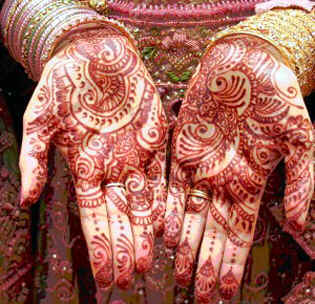Nandini
“Marriage adds relations to life
Music adds celebration to life
Mehandi adorns the hands
And adds divinity to life”………
Mehandi is a symbol of life and prosperity. Word mehandi is derived from the sanskrit word ‘mendhika’ or ‘Heena plant’.It is used for skin decoration in India, East Asia and Africa.In our countrymehandi is just not an art rather it is a custom and the integral part of Hindu and Muslim culture. It would be right to say that festivals like KarvaChauth, Diwali, Bhaidoj, Eid-ul-Fitr and Eid-ul-Azha are incomplete without it. Moreover in Indian marriages a special ceremony called ‘mehandiraat’ is organised to decorate brides and grooms and to bestow them good luck. Relatives also take part in this event by applying mehandi and generally with folk music and dance this eve is enjoyed.
Mehandi has a very cool effect on skin. Its leaves can be used to treat baldness and provide shine to ruff and dry hair. Bark of henna is used in ayurvedic medicines to treat dysentery, jaundice and sore throat. Recently German scientists have reported that the use of p-phenylenediamine (a synthetic dye) in tattoos causes skin infections and allergies but as no such thing is used in mehandi so it safe and hygienic. As far as the youth of Jammu is concerned, Disha ,a student of JU says “I love to try different mehandi designs .Its fragnance is amazing . It is always in trend and inexpensive.”Madhu Sharma, a homemaker quotes “It creates a feeling of festivity and cherishes my marriage’s early days.”
It would be very intresting to know why hands and feet are more often stained by mehandi than other body parts? Logical answer to this question is ‘Melanin’ or skin colour determent. Actually, the level of melanin in these regions is low as compared to the body which results in better stain and of course flaunting factor is also a big reason. Few decades back mehandi was applied with match sticks or pointed sharp thorn sticks but now it is replaced by cones , painting brushes and jacquard bottles. According to Rakesh , a mehandi artist in Bahu Fort , ” cones are more convenient and help to create more clear and webbed designs. It also gives hygiene satisfaction to customers.”
Tanya Gupta, a professional says, “The best procedure which can be followed at home for better stain is to leave mehandi for atleast 3-4 hours and apply a mixture of lemon and sugar to it when cracks are visible. It would be good if painted area is wrapped with tissue, plastic or cloth so as to lock in the body heat which creates a intense colour”.
There are numerous styles and patterns available in the market and some of the most in-fashion are: Silver mehandi, Golden mehandi, Sparkle mehandi, Reverse mehandi, Black cone mehandi, Fabric mehandi, Arabic mehandi, Colour mehandi, Gujarati mehandi, Bombay style mehandi and Rajasthanimehandi.


